Why you can trust Tom's Hardware
CPU-only thermal results with PBO enabled: AMD Ryzen 9 9950X3D
Without power limits enforced, the hottest CPUs on the market will hit their peak temperature (TJ Max) and thermally throttle with even the strongest of air coolers, and even most liquid coolers on the market, in intensive stress testing. For the best liquid coolers on the market, the results of this test will be shown using the CPU’s temperature. However, when the CPU reaches its peak temperature, I’ve measured the CPU package power to determine the maximum wattage cooled to best compare their performance. It’s important to note that thermal performance can scale differently depending on the CPU it’s being tested with.
We’ll start by looking at the performance of this cooler with AMD’s newly released Ryzen 9 9950X3D CPU, with the disclaimer that I’ve only had a limited amount of time to test coolers with this system and Arctic’s previous coolers have performed better on AMD systems.
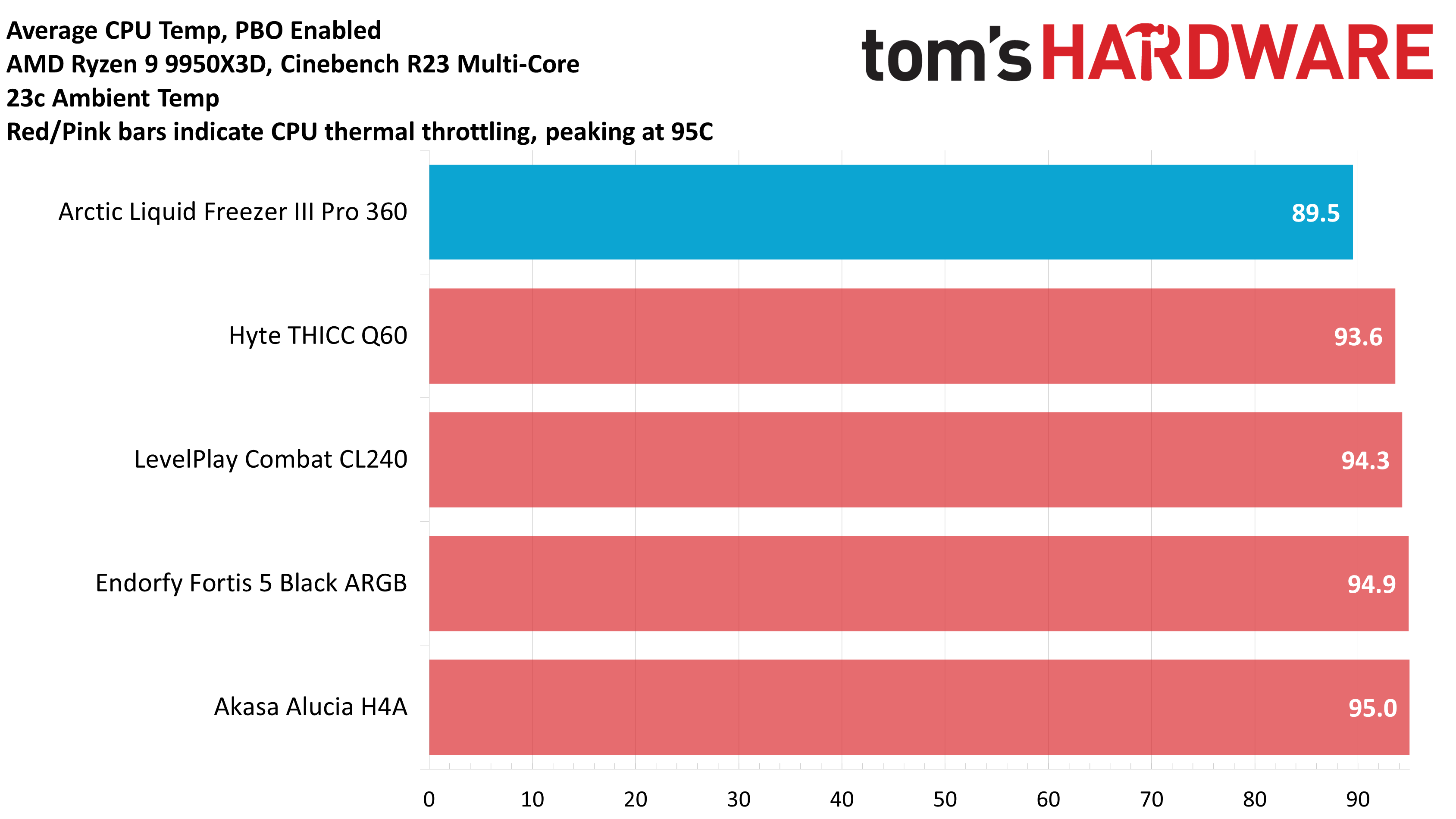
Honestly, the results shown above blew my mind. When even Hyte’s massive THICC Q60 throttled after enabling PBO – I doubted that any AIO could fully tame AMD’s Ryzen 9 9950X3D - but Arctic proved that assumption wrong, easily taming AMD’s flagship CPU!
CPU-only thermal results with power limits removed: Intel’s i7-14700K
My last reviews of Arctic’s Liquid Freezer III did not show impressive performance with Intel’s i7-13700K or i7-14700K – at least when pure CPU performance was being considered.
Arctic’s engineering team appears to have taken my feedback to heart, as they delivered the most incredible performance improvements that I have ever seen in an AIO – thrashing their competition, outperforming the closest competitor by a whopping 13 degrees C! I was convinced I had made a mistake or some kind of error, until I retested Arctic’s Liquid Freezer III Pro again the next day, finding the same incredible results!
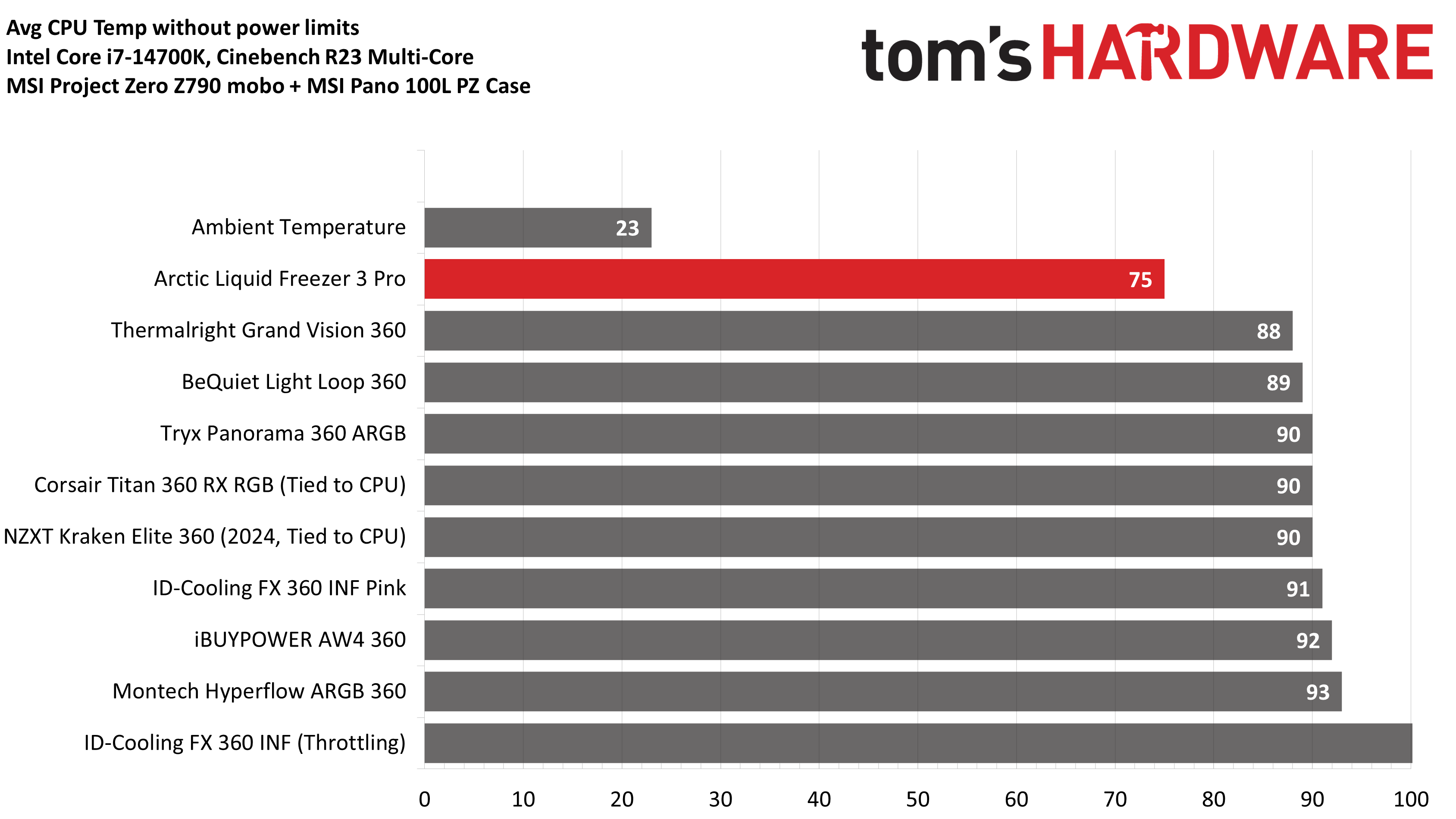
But of course, a cooler’s maximum performance can’t be considered in and of itself. You should also consider the noise levels of a cooler. And to be honest, this is Arctic’s noisiest product yet, reaching a whopping 52.6 dBA! If you are sensitive to noise, you’ll want to limit this AIO’s fan speeds.
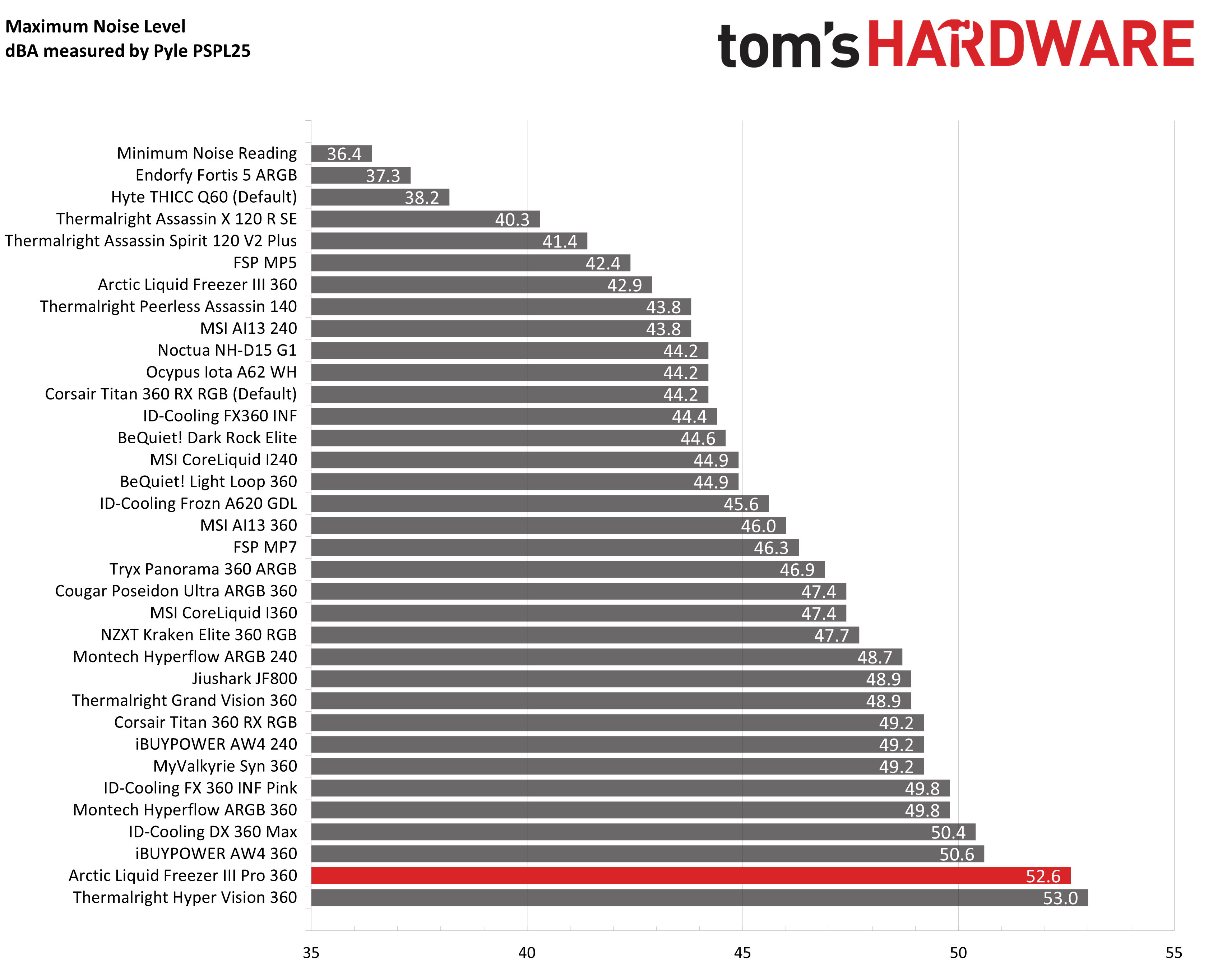
CPU-only thermal results with noise normalized to 38.9 dBA
Finding the right balance between fan noise levels and cooling performance is important. While running fans at full speed can improve cooling capacity to some extent, the benefits are limited and many users prefer a quieter system.
Get Tom's Hardware's best news and in-depth reviews, straight to your inbox.
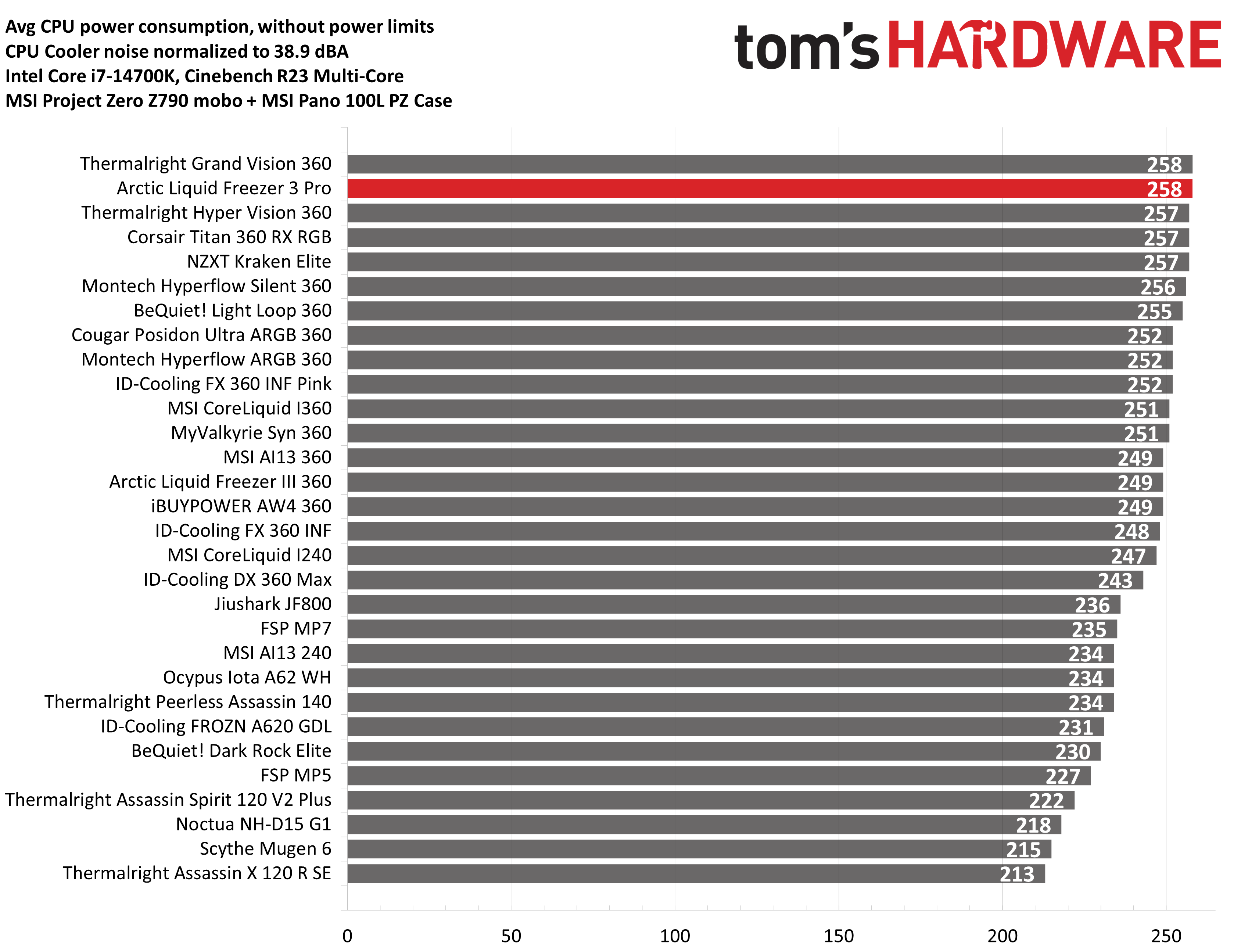
With this noise-normalized test, I’ve set noise levels to 38.9 dBA using the i7-14700K system. This level of noise is a low volume level, but slightly audible to most people. The LF3 Pro reigns supreme here, tying for the best results I’ve seen from any AIO yet.
I’ve also begun to test noise-normalized results with AMD’s Ryzen 9 9950X3D, but I’m going to wait until I’ve recorded more data to present this information. One important observation from this testing: the pump will interfere with lower levels of noise-normalized testing if it is run at 100% RPM. If you want a silently running cooler running less than 38.2 dBA, you’ll need to run the pump at less than maximum speeds.
200W Power Limit
My older reviews have focused more on tests with both the CPU and GPU being stressed, but many of y’all have indicated that you would like to see more CPU-only tests. So we’re going to look at thermal and noise performance for AMD’s Ryzen 9 9950X3D at stock CPU settings – which limits power consumption to 200W.

There’s only a limited selection of coolers here, because I’ve only just started testing AMD’s new flagship CPU. However, it is no surprise Arctic dominates this chart based on our earlier results. It does get a bit noisy by default, so again I’d advise limiting maximum fan speeds.
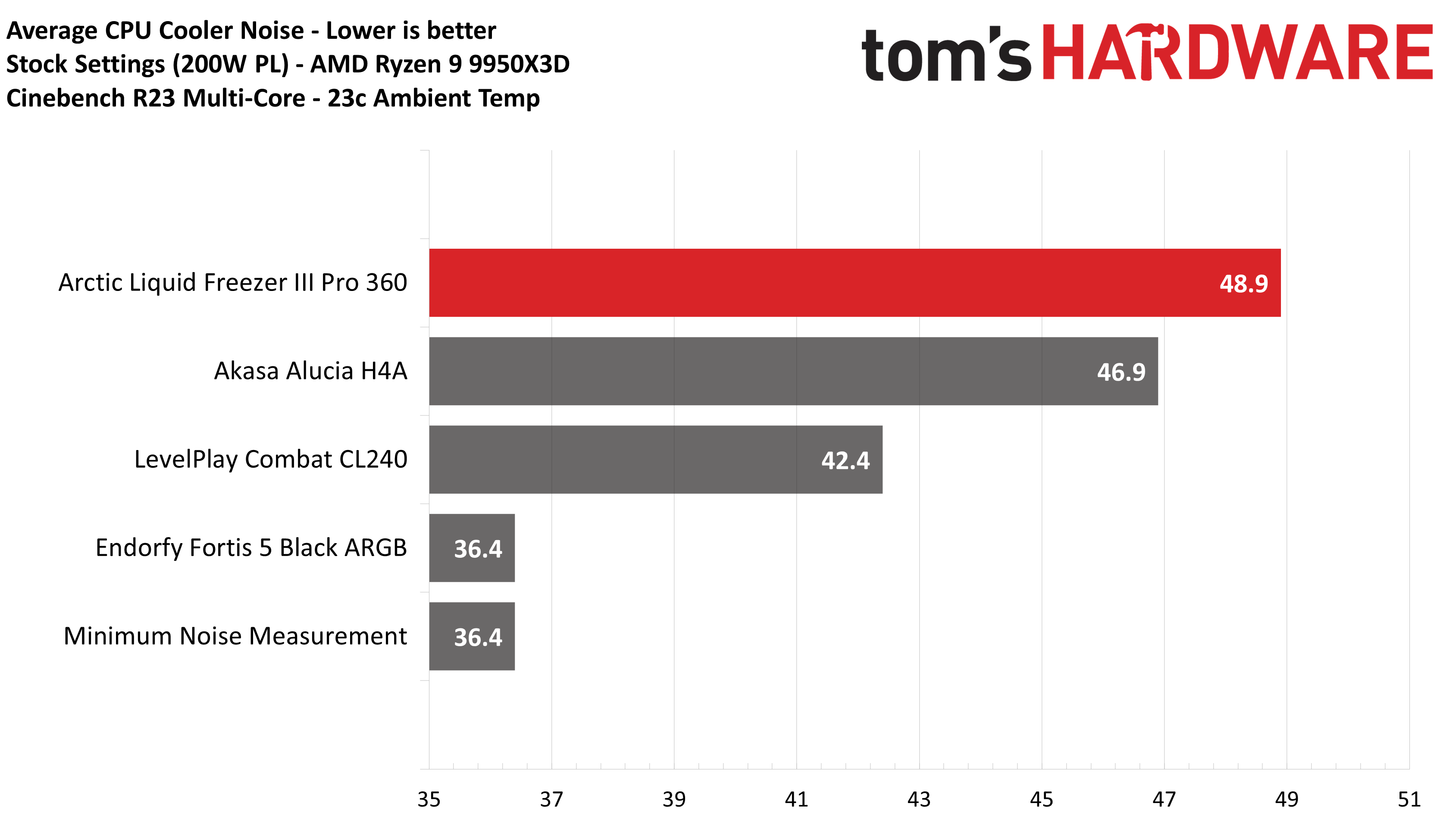
150W CPU + 290W GPU results
Testing a CPU Cooler in isolation is great for synthetic benchmarks, but doesn’t tell the whole story of how it will perform. If your GPU is running a full load, that heat doesn’t just disappear – it makes it harder for your CPU cooler to do its job due to the increased heat within your computer case.
The CPU power limit of 150W was chosen based on the worst CPU power consumption I’ve seen reported in gaming with AMD’s Ryzen 9 9950X3D. My personal experience has shown most games to use much lower amounts of power, but this might be biased by the games I play.
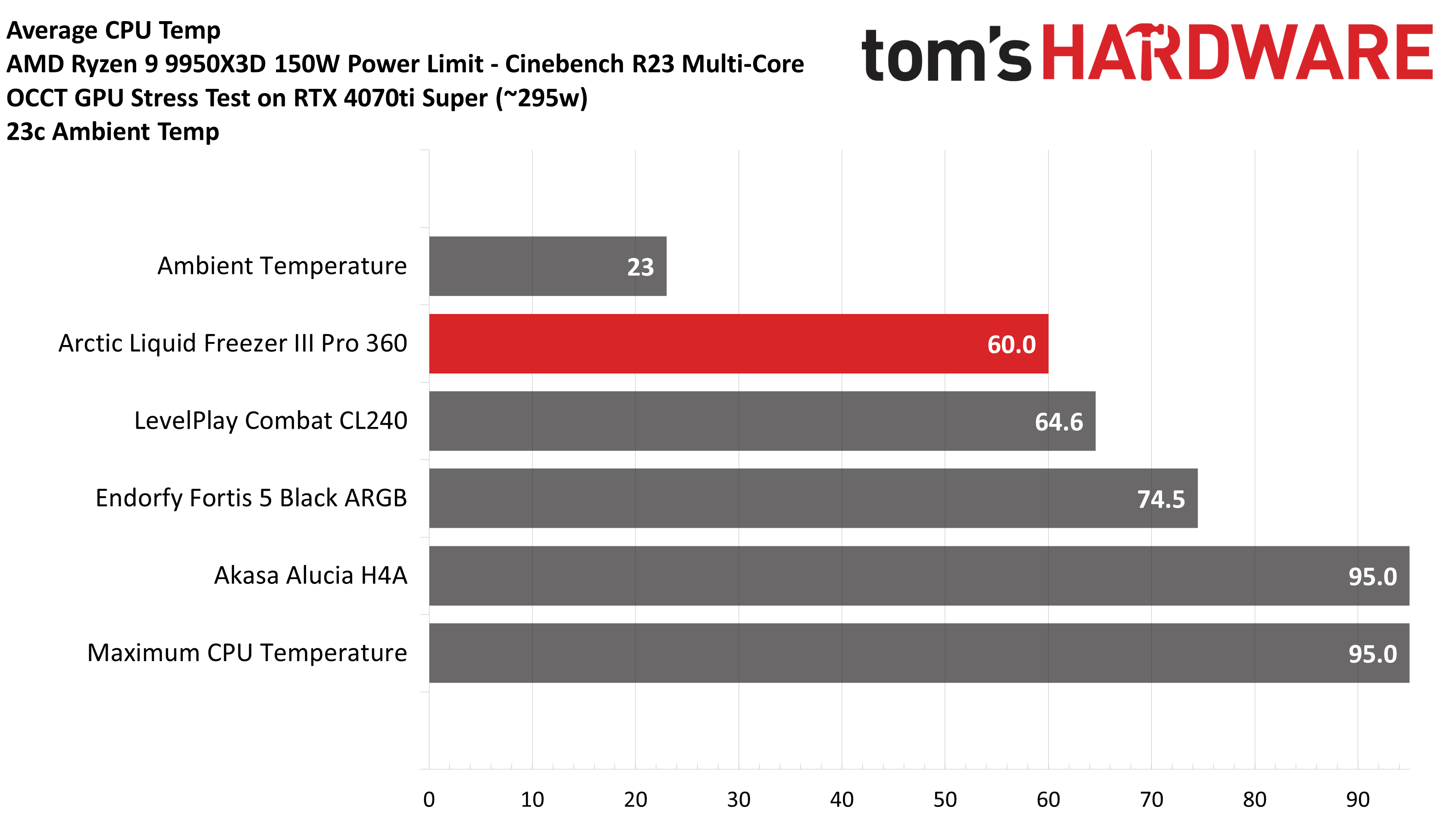
The lead over competing liquid coolers lowers in this scenario, but Arctic commands a significant improvement over air coolers – nearly 15C! Noise levels are tolerable here, reaching 43.8 dBA. This isn’t quiet, but it’s not too bad either.
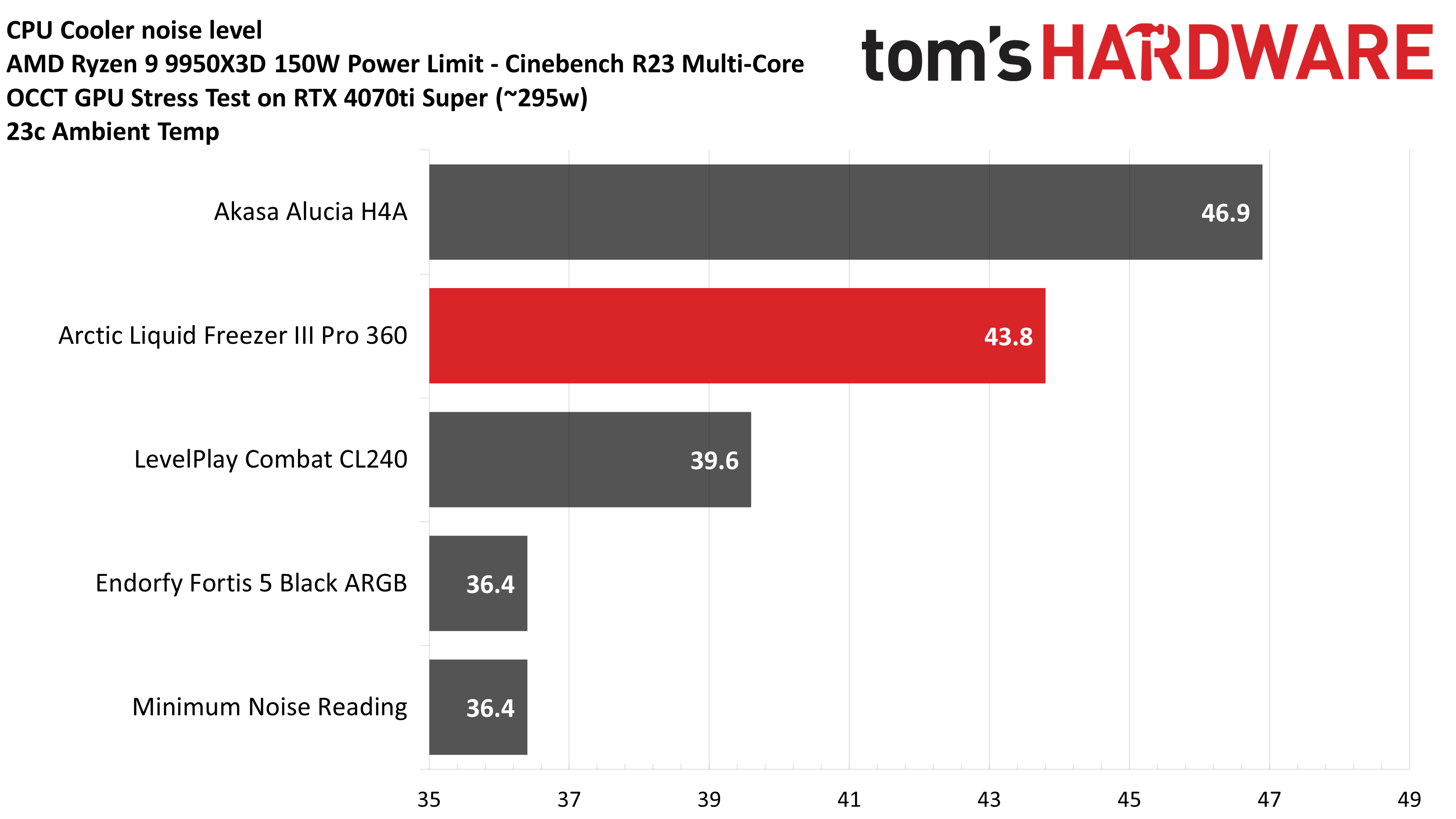
140W CPU results
The last round of test results we’ll look at in today’s review is a test with a 140W power limit imposed. This level of power is dramatically easier to cool for most CPU coolers – and as a result, this is the easiest test we’ll run with AMD’s Ryzen 9 9950X3D CPU for liquid coolers – but I’ve recorded lower power results for comparisons with SFF and air coolers for future reviews.
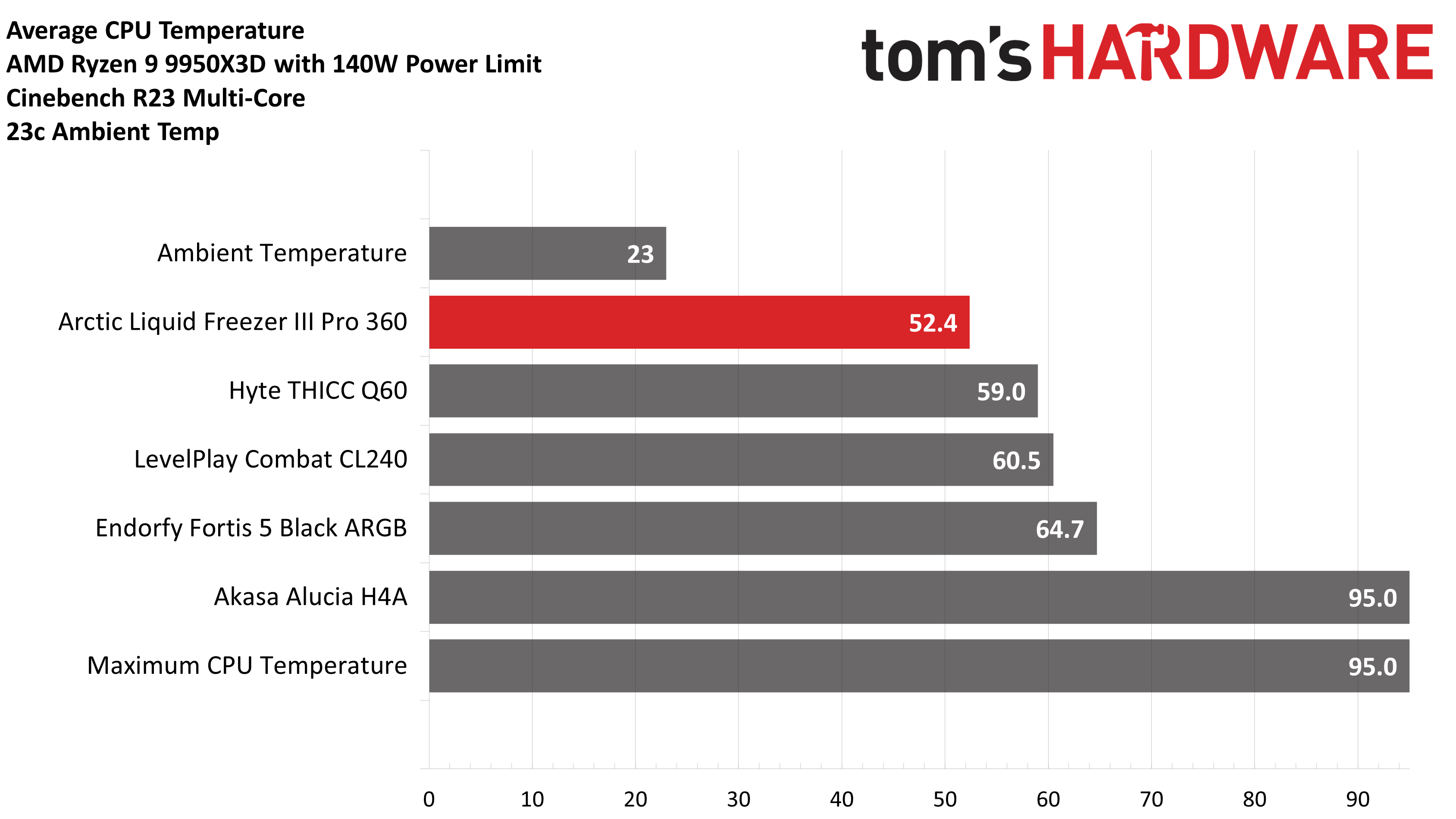
In line with the rest of our test results, Arctic’s Liquid Freezer III Pro delivers outstanding performance – even outperforming Hyte’s infamous THICC Q60 by over 6C!
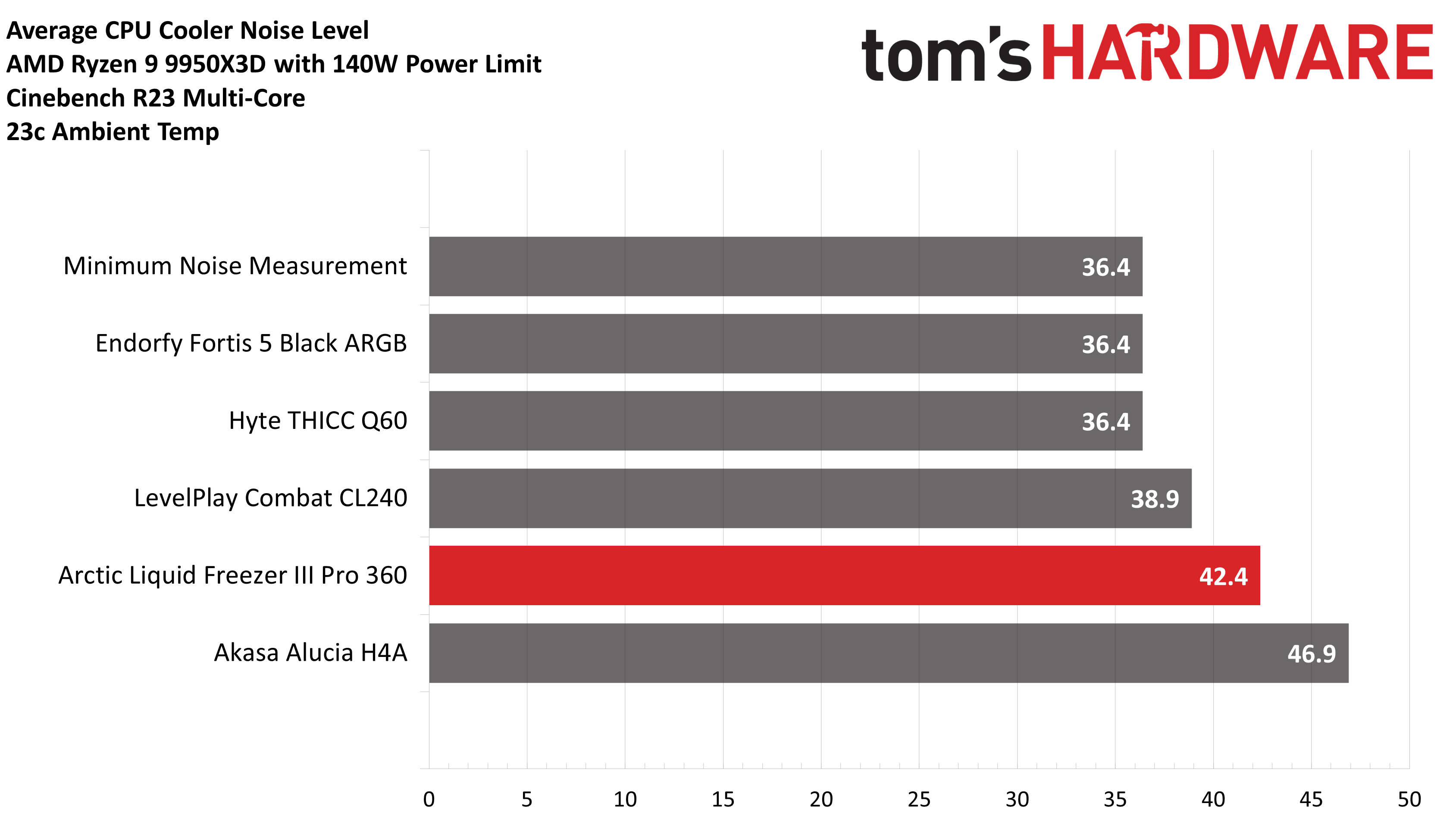
Conclusion
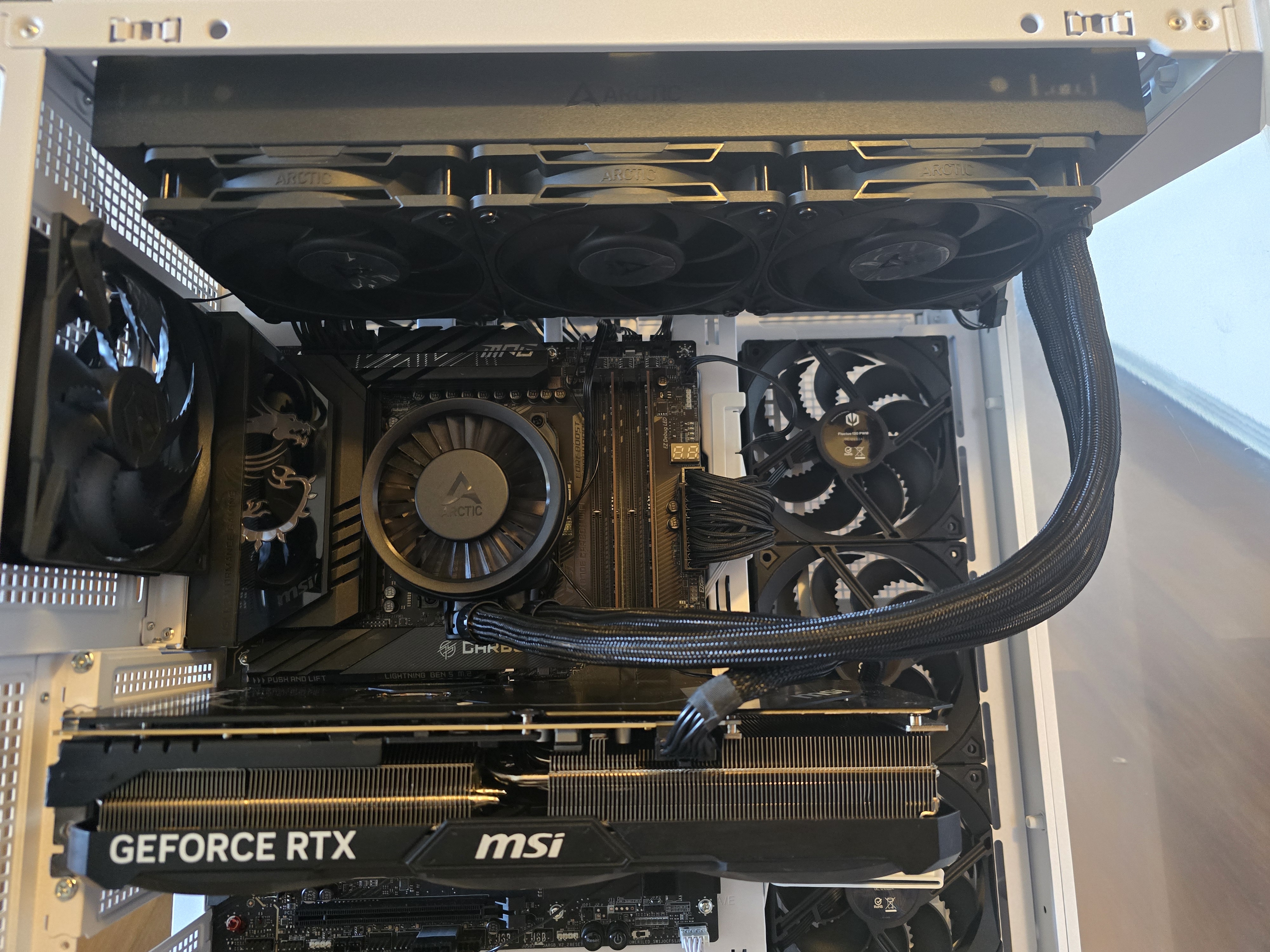
Arctic’s Liquid Freezer III Pro delivers outstanding performance, taking the thermal crown when tested with both AMD and Intel’s most difficult to cool CPUs. At only $125 USD, it offers a relatively budget price – and can often be found for even less (it was selling for just $89 on Amazon when this was edited). The LF3 Pro is an improvement in every way compared to its predecessor, earning our rarest rating – 5 stars! My biggest complaint is that the fans can run a little loud; most users will want to limit the maximum speeds of the fans. Other than that, the LF III Pro is basically AIO perfection.

Albert Thomas is a contributor for Tom’s Hardware, primarily covering CPU cooling reviews.
-
JayGau It's astonishing to give 5 stars to an AIO that doesn't have the most basic feature any AIOs should have: a liquid temperature sensor. It's like buying a car without a temperature gauge. The liquid temperature is the most important and critical data on your AIO. The fans are not cooling down the CPU, they are cooling down the liquid.Reply
You say the fans are loud, and so many people are complaining that AIOs are louder than air coolers, which for me is a total nonsense. AIOs are much quieter than air coolers, it's not even a contest, as long as you use them properly. Of course if you set the fans with the CPU temp you gonna have 3 fans (for a 360mm) bursting like hell every time the CPU does something. But if you set them with the liquid temperature instead (which is what the fans are cooling down), you barely notice them since the liquid never goes really hot and its temperature changes very slowly.
It's unbelievable that in 2025 most AIOs don't even have this functionality. But I guess manufacturers don't really care since they know most people don't even know how those coolers work anyway. -
Elusive Ruse Thanks, these results are more in line with what I expect from an Arctic AIO, I will be on my LFII 360 as long as I keep my 7950X because it’s been incredible but my next AIO is most definitely going to be this one.Reply -
Albert.Thomas Reply
I understand why some people would prefer to tie fan speeds to liquid temperatures, but I don't like it *most* of the time.JayGau said:It's astonishing to give 5 stars to an AIO that doesn't have the most basic feature any AIOs should have: a liquid temperature sensor. It's like buying a car without a temperature gauge. The liquid temperature is the most important and critical data on your AIO. The fans are not cooling down the CPU, they are cooling down the liquid.
While I appreciate the lack of fan bursts, there's a few reasons I do not use coolers this way.
Scenario #1: Near-term throttling. When you use a cooler that operates based on liquid temp, your CPU can hit TJMax and throttle as a result - while the cooler stays in low operation because the liquid temperature hasn't warmed up yet.
Scenario #2: Extended high speed fan duration. If you run a high intensity load for more than a few moments - lets say a full CPU load for 10 minutes - it is gonna take a while for the liquid temp to cool. A traditional cooler will lower fan speeds almost immediately after a workload ends. However, a cooler tied to liquid temperature will take two or three minutes to return to low fan speeds.
I test things using the motherboard's default fan curve. While you may or may not agree with this, this is how most users will run their coolers.JayGau said:You say the fans are loud, and so many people are complaining that AIOs are louder than air coolers, which for me is a total nonsense. AIOs are much quieter than air coolers, it's not even a contest, as long as you use them properly. Of course if you set the fans with the CPU temp you gonna have 3 fans (for a 360mm) bursting like hell every time the CPU does something. But if you set them with the liquid temperature instead (which is what the fans are cooling down), you barely notice them since the liquid never goes really hot and its temperature changes very slowly.
Noise normalized results are included to show how you can still have higher performance while operating quietly. -
LookHereBub Interesting. After much research I purchased the non-pro LF3 middle of last year when I built my current system. I have found it excellent in all respects, keeping my 12900ks from throttling even under heavy assault using cinebench. Under normal use with most games CPU rarely gets over 50-60C. Not sure I would need to upgrade, but nice to see them making good improvements. Nice review, thanks.Reply -
AmirTHforum This review is very disappointing!Reply
I just built a new computer, and I made my decision on your review on April 6, 2024.
https://www.tomshardware.com/pc-components/liquid-cooling/arctic-liquid-freezer-iii-aio-review
When I saw this review I said to myself; ok, maybe someone else at TomsHardware has a different opinion; but no it's the same person doing the same review on the same product. Now all of a sudden, you go from 2.5 stars to 5 stars.
Now I can understand rerunning the test and using "Updated cooler testing methodology" (August 18, 2024).
https://www.tomshardware.com/pc-components/liquid-cooling/a-second-look-at-arctics-liquid-freezer-iii-using-our-updated-cooler-testing-methodology#xenforo-comments-3852191
But how do you go from; "Unimpressive" to "The best AIO for Ryzen 9950X3D, and Intel too"?
What happened?
Did Arctic call you and yell at you for giving a bad (but true) review?
Or is Arctic Liquid Freezer 3 is a great product and your initial testing was that wrong?
One last thing; you (Albert Thomas) got a little defensive when readers questioned your review (April 6, 2024), and you were adamant, that your methodology was better and more accurate that the rest of the reviewers online. -
-Fran- Thanks for the data as always Albert.Reply
Would you ever test the lil' bro of this one: LF3-240, or at least the 280, if there's a version of them?
Also, are you sure it's 200W for the 9950X3D? Mine goes all the way to ~240W at stock. Since my LF2-240 can't keep up with it past ~200W (I may need to consider de-lidding xD), it only bursts until temps catch up and it ramps down.
Regards. -
Albert.Thomas Reply
Please re-read the review in detail.AmirTHforum said:When I saw this review I said to myself; ok, maybe someone else at TomsHardware has a different opinion; but no it's the same person doing the same review on the same product. Now all of a sudden, you go from 2.5 stars to 5 stars.
This is NOT the same product. If you pay attention to the results using Intel's i7-14700K, you'll see results with both the original Arctic Liquid Freezer III reviewed last year and the product reviewed today which is the Liquid Freezer III Pro
Perhaps Arctic should have given this AIO a new branding to avoid any confusion -
Albert.Thomas Reply
If Arctic releases this AIO in another size, I'm sure management wouldn't mind a look at another variant given this model's impressive performance.-Fran- said:Thanks for the data as always Albert.
Would you ever test the lil' bro of this one: LF3-240, or at least the 280, if there's a version of them?
Also, are you sure it's 200W for the 9950X3D? Mine goes all the way to ~240W at stock. Since my LF2-240 can't keep up with it past ~200W (I may need to consider de-lidding xD), it only bursts until temps catch up and it ramps down.
Regards. -
Elusive Ruse Reply
I highly doubt it goes that high without PBO enabled.-Fran- said:Thanks for the data as always Albert.
Would you ever test the lil' bro of this one: LF3-240, or at least the 280, if there's a version of them?
Also, are you sure it's 200W for the 9950X3D? Mine goes all the way to ~240W at stock. Since my LF2-240 can't keep up with it past ~200W (I may need to consider de-lidding xD), it only bursts until temps catch up and it ramps down.
Regards.
https://tpucdn.com/review/amd-ryzen-9-9950x3d/images/power-multithread.png
